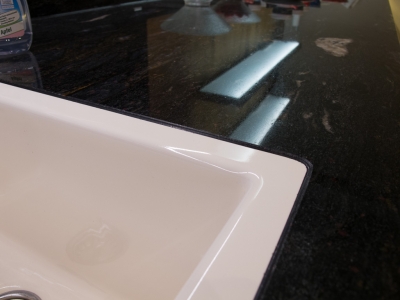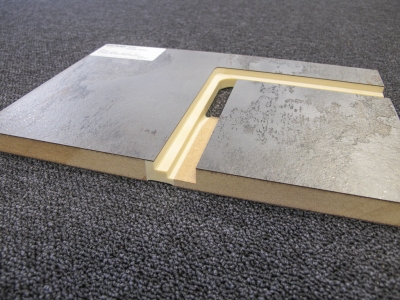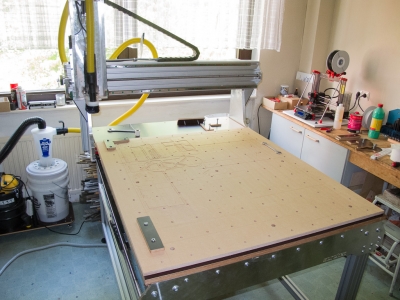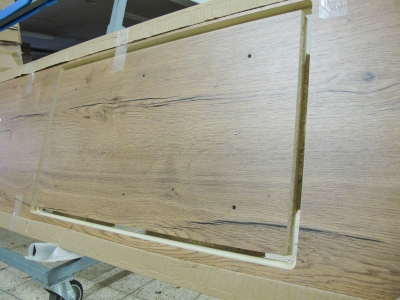S-thinking vs. N-thinking and big vs. small companies
After the last posts you can almost imagine it, but I currently have such a case of low motivation. Interestingly, diary writing works very good and this blog here is essentially that. I can thank my luck that everything worked out otherwise I would be out of commission for weeks, this experiment has actually worked and illustrates just very well the difference between sensor (S) and intuitive (I) types.
To understand what this is about, I have to explain: There are two ways to install built-in sinks in kitchen worktops: laid-up and flush-mounted, so there is no protruding edge :
The problem was for years that this was only possible in waterproof materials, because you have to mill a rebate in the material and in a chipboard you cannot make the cut edge totally sealed and it inevitably swells up. There were manufacturers offering solutions for factory-builtin sinks, but these were expensive and limited to the models they had in stock. Until somebody had this idea:
With this installation technique, you can install any flush-mounted sink quite inexpensively in the classic worktops and our kitchen supplier has now included this technique in his product range. (However, somewhat simplified, instead of the fold they deliver wooden ledges). What follows now is once again a classic example of the dynamics of large companies and the fundamental difference between sensors and intuitives. In any case, my father sold such a built-in basin, but our supplier said that they did not have this model in their range and therefore could not make the cut-out. To say the least, that is nonsense. The only difference is that the model is 850 mm wide and that one in the assortment 900 mm, so it is a single value to change in the file. But that's not accounted and they just do not do it.
But now I had this sample of another manufacturer and the yellow filler seemed familiar to me, because that looked very much like the resin that I used in model making. And if you look at the piece more closely then it is also clear how it was done: first milled from the bottom side a groove up to the laminate, then poured that out with resin and milled in the last step from the top side the cutout with fold. Because since last year I have a CNC portal milling machine with a working area of 100x110 cm, so is was big enough for this section.
When I told my chief fitter (most likely an ESTP), he was very skeptical and brought arguments like "if that were so easy, our great competitor with 50 people in the shop and professional machines would do it, you have only a hobby mill" or "if you do not cut right down to the Laminate it will not be tight and will only cause problems" and "that's so much work, you can not earn anything with that" and "the customer would have bought the other sink" and so on. Well, my router cost only 5,000 euros and not 50,000 (NB: that was twice as much as I originally wanted to spend, but in terms of the possible applications, I didn't want to skimp in the wrong place), but that expresses itself only in motorization, speed and size, not precision.
For me there is something else more important: The opportunity to try something new and to expand my skills, in this case I may not be able to make profit, but at least don't have to work for free. As far as I could foresee this is not a problem of milling so accurately as the machine has a base plate that I have milled exactly level and I can screw the workpiece firmly on it. And I have already worked with the cast resin, if not in such quantities and it it not that expensive. If, of course, everything goes wrong, then 20 € cast resin is gone, the worktop for 200 and probably the worst is that we can not deliver on time, so a there is a certain risk. But there is an interview with Adam Savage on Youtube which unfortunately I can not find anymore. There he says exactly that: He has made in his career as many such jobs as possible to try something new and expand his skills.
The actual implementation was then no problem: To model the cutout and the groove in the CAD and to generate the milling data. Somewhat inconvenient was the fact that the router is in my apartment and the room is a little too small for a 3.20 meter long panel, but typically for me I wired the thing so that it is not tied to exactly that position, so I put the machine on trolleys (clear, CNC machined ..), turned it around and pushed the plate in through the window. When milling I was also extra careful and checked everything three times, I could absolutely not afford a crash and I have only one extra-long 12 mm cutter. So it took a little longer and was not cost effective, but it finally worked fine: Milling, the last few 1/10 mm in single steps until you are exactly on the surface, mix resin in several portions and pour (that was 1.5 liters ..), turn it around the next day and finish milling.
So, if that happens more often now, I really only need to change the size parameters, the milling strategy with feeds and cut steps will remain the same and then that's also easily covering costs. Well, it did not all go 100% smooth: I had take the position of the cut out of a granite worktop and after everything was poured I noticed that this was a handle-less kitchen where the countertop protrusion is smaller. You could have moved the cut actually a little further back, but the granite worktop supplier also does not do that as I found out in the middle of the night to my relief. Well, and somehow I was wrong in ordering the resin, I only got one liter after my first quantity calculation and that was not enough. But that was - typically INTJ - no problem because I had a partly used 2-liter container from my modeling and for the case that that would not be enough that was already planned as a backup solution.
And finally to the argument why our competitor does not do that: They have 50 people in the workshop, an extra design department, the sales and the management. Who should come up with the idea that they can do it themselves and do it? The sales people go the easy way and sell what they already have. Without an impulse, no one from the design department will go into it, the workshop only builds what it is told to and the management knows nothing of the situation. That's just the big difference when all these departments are united in a personal union, then you are simply flexible to try something like that. And it just needs an intuitive seeking the challenge "can I do that too?" to actually do that.





Kommentare
Ansicht der Kommentare: Linear | Verschachtelt